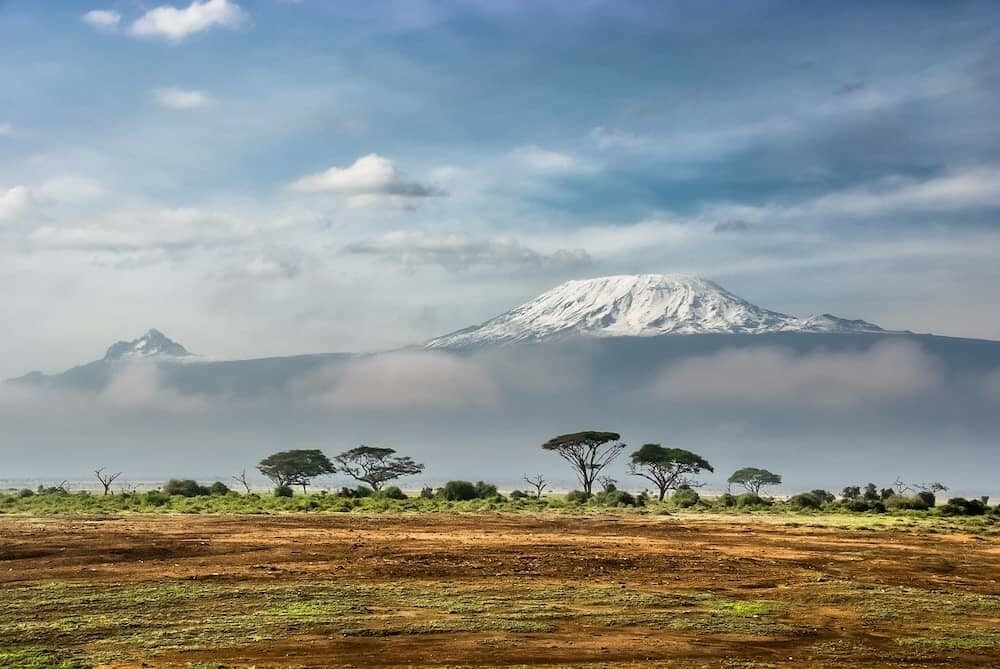Our journey in today's read will take us to a high-rise, above-sea-level area somewhere in the wilderness of East Africa where a mountain rock described as a stratovolcano of about 4 million years old is still sitting pretty.

Located in Tanzania, Mount Kilimanjaro is Africa’s tallest mountain at about 19,340 feets. It is the largest free-standing mountain rise in the world, meaning it is not part of a mountain range. The mountain lies about 100 miles (160 km) east of the East African Rift System and about 140 miles (225 km) south of Nairobi, Kenya. It also extends approximately east-west for 50 miles (80 km).
In 1889, German geographer Hans Meyer and Austrian mountaineer Ludwig Purtscheller became the first people on record to reach the summit of Kilimanjaro. Since then, Kilimanjaro has become a popular hiking spot for locals and tourists. In 1973, the mountain and its six surrounding forest corridors were named Kilimanjaro National Park in order to protect its unique environment. The park was named a United Nations Educational, Scientific and Cultural Organization (UNESCO) World Heritage site in 1987. A variety of animals live in the area surrounding the mountain, including the blue monkey (Cercopithecus mitis).
According to the World Wildlife Fund travel channel, it is reported that approximately 25,000 people attempt to summit Mt. Kilimanjaro annually and only about two-third of these individuals are successful. South African Bernard Goosen twice scaled Mt. Kilimanjaro in a wheelchair. His first summit, in 2003, took nine days; his second, four years later, took only six. Born with cerebral palsy, Goosen used a modified wheelchair, mostly without assistance, to climb the mountain.
The fastest verified ascent of Mt. Kilimanjaro occurred in 2001 when Italian Bruno Brunod got to the Uhuru Peak of the mountain in 5 hours 38 minutes 40 seconds. The fastest roundtrip was accomplished on 26th December 2004 when local guide Simon Mtuy went up and down the mountain in 8 hours, 27 minutes. The run was recognized as an official Guinness World Record for unassisted ascent-descent on Kilimanjaro.

Mount Kilimanjaro, or just “Kili” to many who are given to climbing or hiking, is a major tourist attraction in Africa. For those seeking an adventure holiday, a trek to the peak of Mount Kilimanjaro is perhaps the epitome of such a vacation.
Standing at 5,895 meters tall, it takes around 5 to 10 days to get to the summit and return to the foot of the tallest mountain in Africa. The climb does not really require any specialist climbing equipment, but the right level of fitness is essential. However one has to be wary of altitude sickness, this is a prevalent problem among those who attempt the climb.
So as you prepare to climb, you must note that the weather conditions at the base of the mountain and on your journey to the top vary quite significantly. Traversing from the bottom to the summit is like taking a journey from the equator to the North Pole in just a matter of days. The Kilimanjaro treks come as organized tours. There are porters and tour guides to help you carry most of your stuff. You must ensure to pack light and pick only essential items that would keep you in good shape on the journey to the top of the mountain. Since you most likely will be staying in a hotel before and after the trek, you can pack clothes to cater to the trip and separate them from what you will wear after the hike (pre and post-hike). Set The weather can be pretty unpredictable on the mountain, so it is wise to bring a couple of thick and thin layers of clothing so you can adjust accordingly when the weather changes.

Also since the weather can be pretty unpredictable on the mountain, it is wise to bring a couple of thick and thin layers of clothing so you can adjust accordingly when the weather changes. You would need a trekking T-shirt, a regular shirt (for after trekking hours), hiking pants, trekking boots, waterproof pants, waterproof jacket, trekking socks, insulated jacket, gloves, sun hat or head warmer, trekking poles, a portable solar power bank, a camera and a headlamp, for nights at the top of the mountain. This is already looking like a once in a lifetime adventure. Isn't it?
Best times to visit are between January and March, as it is much colder during this time, with the potential of snow. June to October is also a good time. Africa is a spectacle to behold and you are bound to have a good time and your money's worth whenever you visit some of the tourist sites we recommend on this blog. In the beauty of tourism, therein lies the power of Africa.
